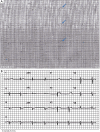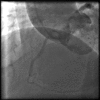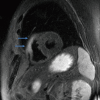Conus artery occlusion causing isolated right ventricular outflow tract infarction: novel application of cardiac magnetic resonance in anterior STEMI
- PMID: 27280090
- PMCID: PMC4880749
- DOI: 10.21037/cdt.2015.11.05
Conus artery occlusion causing isolated right ventricular outflow tract infarction: novel application of cardiac magnetic resonance in anterior STEMI
Abstract
Acute ST elevation in the anterior precordial leads typically suggests an anteroseptal infarction due to left anterior descending coronary artery obstruction, but the differential can be broad. Conus branch artery occlusion is a potentially overlooked cause of anteroseptal ST elevation myocardial infraction. Cardiac magnetic resonance (CMR) imaging is an emerging technology which can differentiate the etiology of anterior ST elevation in patients with no apparent coronary abnormalities on coronary angiography and normal echocardiography.
Keywords: Conus artery; bicuspid aortic valve; magnetic resonance imaging (MRI); myocardial infarction.
Conflict of interest statement
Figures







References
Publication types
LinkOut - more resources
Full Text Sources
Other Literature Sources
